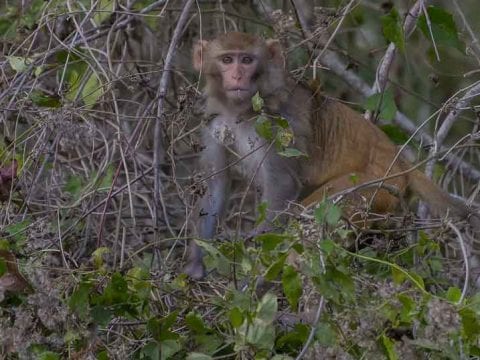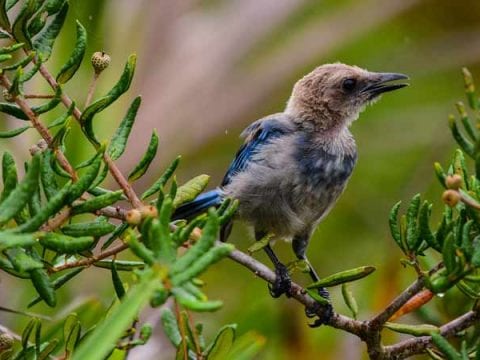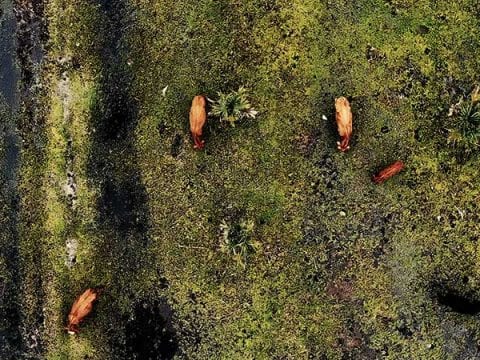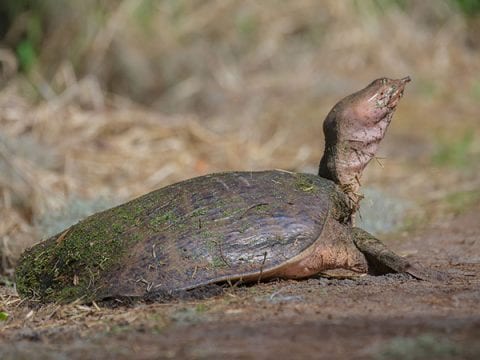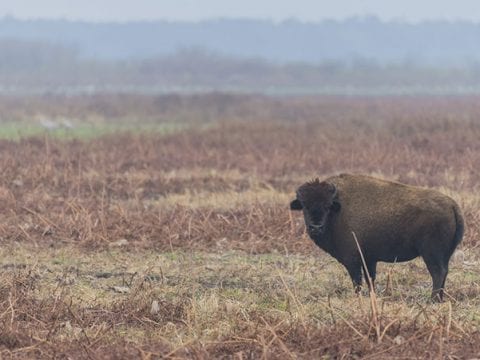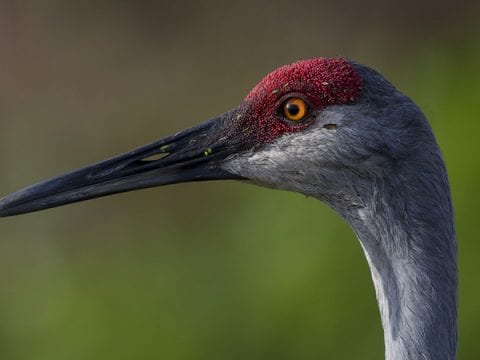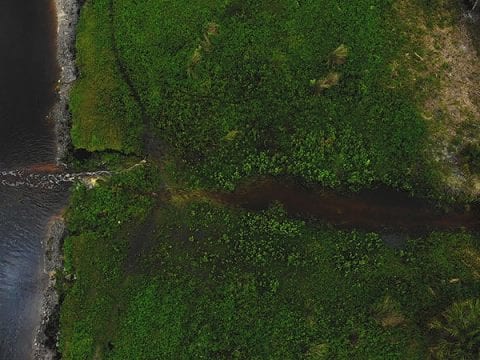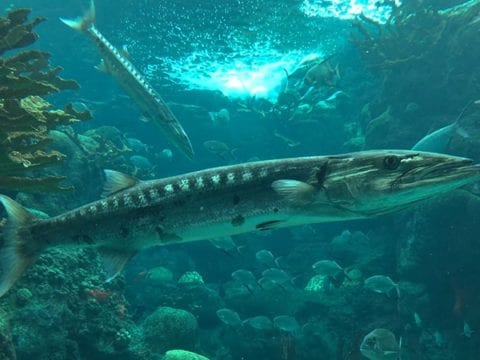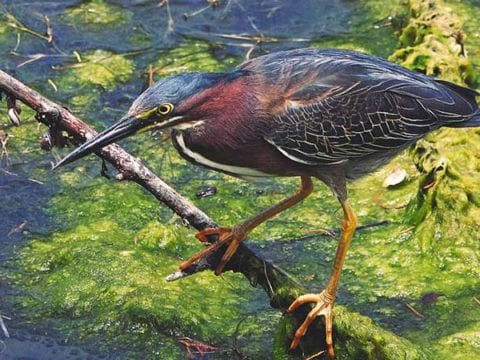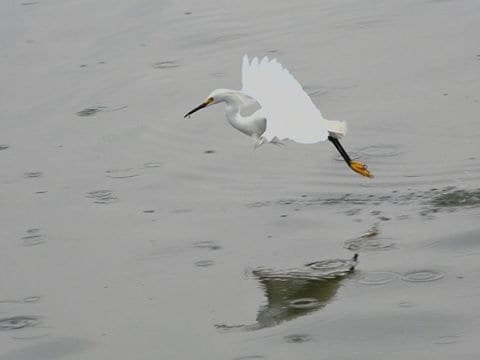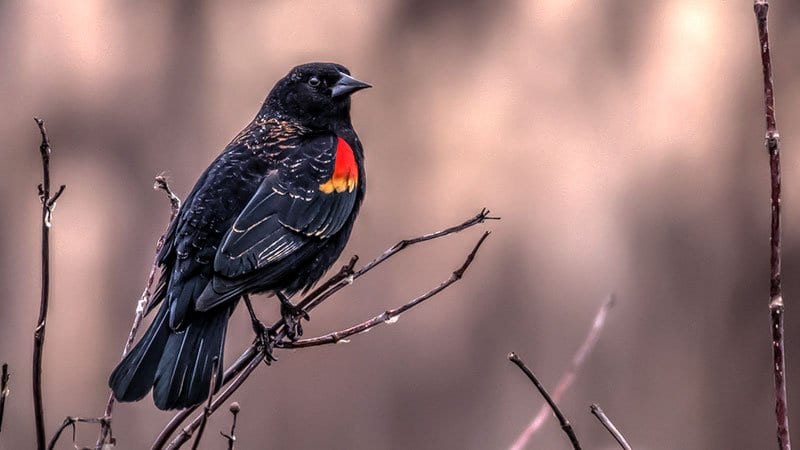
Table of Contents
When I first started hiking around the Potomac River in Virginia is when I first started to notice the red winged blackbird. At first, I thought it was some type of Oriole because of how fast he flew by me and I’ll I saw was orange and black on it. I happened to be out with some birders and they filled me in. The picture of a male above was taken in Huntley Meadows Park in Alexandria, VA. Here are some facts on the red winged blackbird.
4K Wildlife Video Of Red Wing Blackbirds Defending Their Nest From A Great Blue Heron
Red Winged Blackbird Facts
- Found in North and Central America
- Found in salt/fresh water marshes, on golf courses, watercourses, wet roadsides, in meadows (where they breed) and during the wintertime they can be found in pastures or on rice patties.
- They are usually found in flocks.
- red winged Blackbirds are one of the most prolific and renowned birds in North America.
- They are strong and will often attack larger birds such as crows and hawks that fly over their nesting areas.
- They are very quick fliers, up to 28 mph during migration.
- In 1970, there was an estimated 190 million Red winged Blackbirds
- Breeding takes place between Alaska, Newfoundland down to Florida, Gulf of New Mexico, Mexico, Guatemala, El Salvador, Honduras and Costa Rica.
- For winter season, these birds can travel as far north as Pennsylvania and British Columbia but usually move to the southern US states and Mexico.
- Outside of nesting season, red winged Blackbirds roost in huge concentrations
- The arrival of their melodious, happy songs means spring has returned in the North.
- Between 1966-2014, the red winged Blackbird population has declined by 30 percent according to a North American Breeding Bird Survey.
- There are 26 subspecies of this bird recognized worldwide and 14 of them on in North America.
- A California species of the Red Winged Blackbird male doesn’t have the yellow and red shoulder leading the species to be named “Tricolored Blackbird”.
- The oldest Red Winged Blackbird on record was 15 years and 9 months old in New Jersey in 1967.
- The size and proportions of the red winged Blackbird will change within the different populations of the bird.
- In French, the Red Winged Blackbird is known as Carouge à épaulettes.
- In Spanish, the red winged Blackbird is known as Tordo alirrojo, Tordo capitán, Mayito de la ciénaga, Sargento.
A video that I shot showing a balding red winged blackbird. After some research, I found that some birds can get avian alopecia. This is a condition that causes loss of feathers in areas that are hard to preen, like the head portion of a bird. It typically happens during mating season as that brings on a lot of stress for them. The condition should improve over time. Watch the video for more information.
Identification
The red winged Blackbird is one of the more abundant and radiantly colored birds across North America and is sexually dimorphic.
Summer Male
Males have a glossy-black tone to their body and broad-shoulders layered with scarlet and yellow patches, the females resemble that of a dark, larger sparrow.
Winter Male
Same as summer male except for the warm brown feather tips spread out the body.
Female
The females are predominantly different from the males based on their color. They have brown feathers with a white supercilium and peach-colored chin/throat, they resemble sparrows.
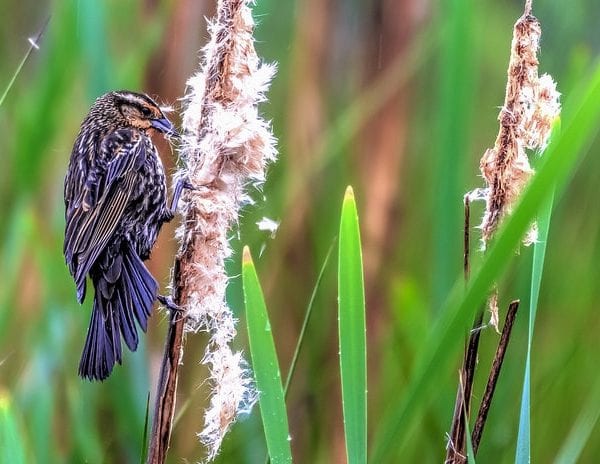
Photograph of a female red winged blackbird collecting material for her nest
Immature Male
Same as winter male but with more brown and more fluff.
Immature Female
Same as winter female but their chin/throat is not peach-colored.
While both males and females sit with a hump-back, have a small, conical bill and a medium-sized tail. The male birds usually sit with their tail slightly flared out while females have a paler breast and a white eyebrow line. The red winged Blackbird male likes attention and therefore strives hard to get it. For example, the male will sit on high cattails and sing a loud song throughout the day, all day. Their call is very hoarse and gurgled. It is his way of boasting toward females, protecting his area and marking his territory, which is very important to the red winged Blackbird. Females are different because they stay low profile where they can forage for food and weave their nests. Their eyes, beaks and feet are all black.
Both genders eat insects during spring/summer and forage for corn, wheat, ragweed and sunflowers during fall/winter. The red winged Blackbird is omnivorous, they eat plants, corn, rice, insects and other small animals such as butterflies, flies, moths, spiders, mollusks, worms, frogs, dragonflies, damselflies, snails and even eggs.
Size
Female
Length: 6.7”-7.1”
Weight: 1.46 oz.
Male
Length: 8.7-9.4”
Weight: 2.3 oz.
Both Male and Female
Wingspan: 3.2”-5.7”
Tail: 2.4”-4.3”
Culmen: 0.51”-1.26”
Tarsus: 0.83”
Nesting
The red winged Blackbird females usually lay 2-3 broods per breeding season and with each new brood, a new nest is built to decrease parasite risk. Each brood contains approximately 4 eggs. The nest is weaved brilliantly with plants foraged by the female and usually spans 4-7 inches across and 3-7 inches in depth and can be found in shrubbery or trees but are usually built on marshes to allow for foraging of seeds, rice plants and wheat. While the males like to boast and sing and the females gather and tend to the nest, both genders come together as a unit if the nest is being threatened by a predator.
Males spend more than a quarter of the daylight hours protecting their breeding grounds from crows, ravens, magpies, foxes, rat snakes, raccoons and herons. Male birds will also swoop down at humans if they feel their nest is being threatened. They are extremely protective and territorial. Because nests are very hard to keep safe from many different types of preying animals on the ground and in the air. red winged Blackbirds use a tactic called Group Nesting. This helps to increase the amount of parents who are watching over the nest. Also, the color of the female feathers can act as a camouflage in the nest through the incubation process. This allows them to better hide themselves and their eggs from outside animals that wish to eat them.
Typically, many female red winged Blackbirds will mate with the same male red winged Blackbird that many other females have mated with as well, causing several nests in one area to be guarded by that same male. In fact, a male red winged Blackbird can have up to 15 different mates per mating season.
Egg Length
0.9”-1.1”
Egg Width
0.6”-0.7”
Egg Description
Pale blue-green to gray with brown/black markings.
Migration
red winged Blackbirds are typically year-round residents all over their range and usually migrate from Northern United States to Southern United States where they breed in the spring. During this migration, they can travel at a speed of 30 mph. A group of red winged Blackbirds migrating together is known as a merl, a cloud or a cluster. In the fall, populations began to migrate to the Southern United States. During the spring, they travel to the Northern United States, specifically the Great Lakes. Females will migrate longer than males and both genders generally migrate during the daytime.

